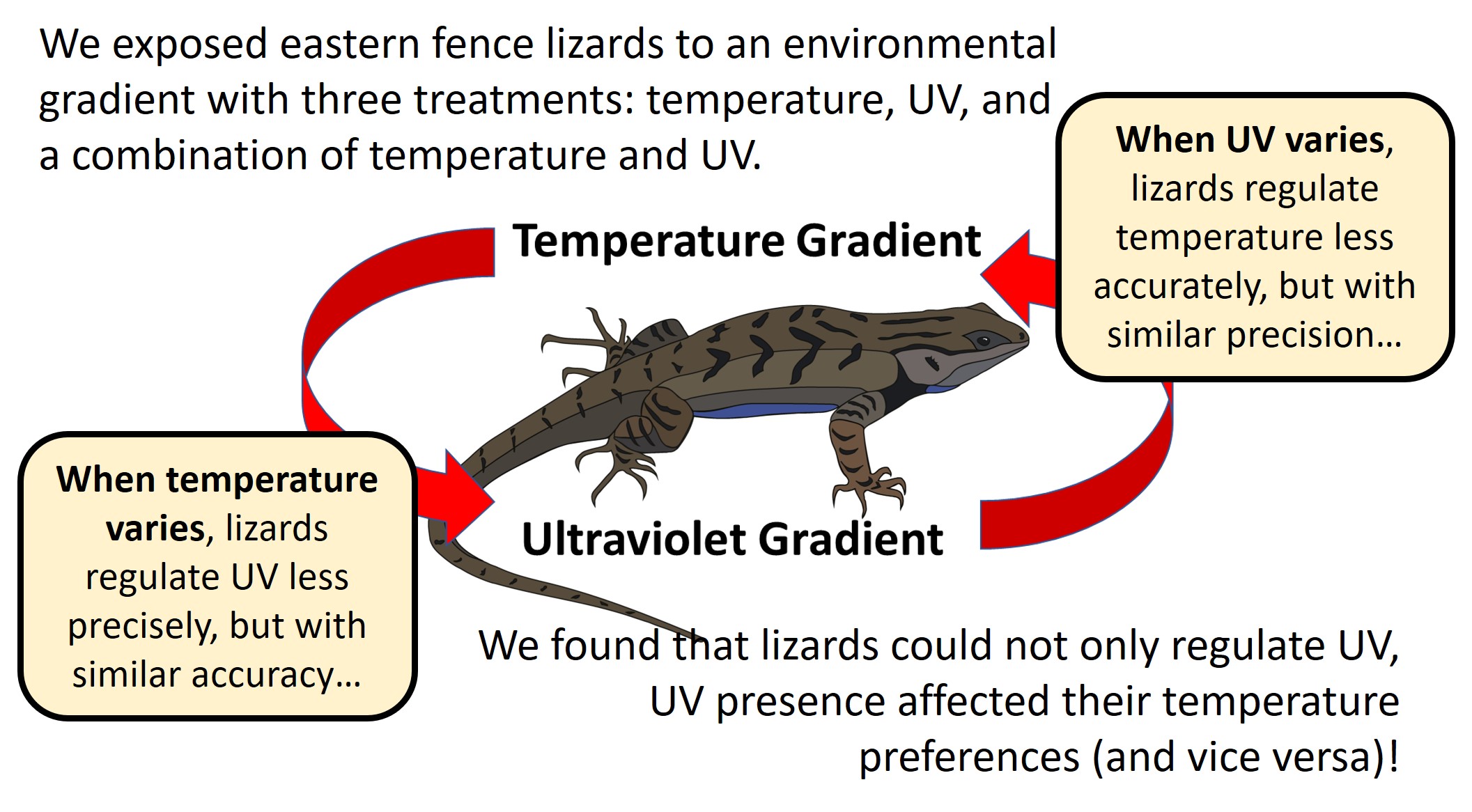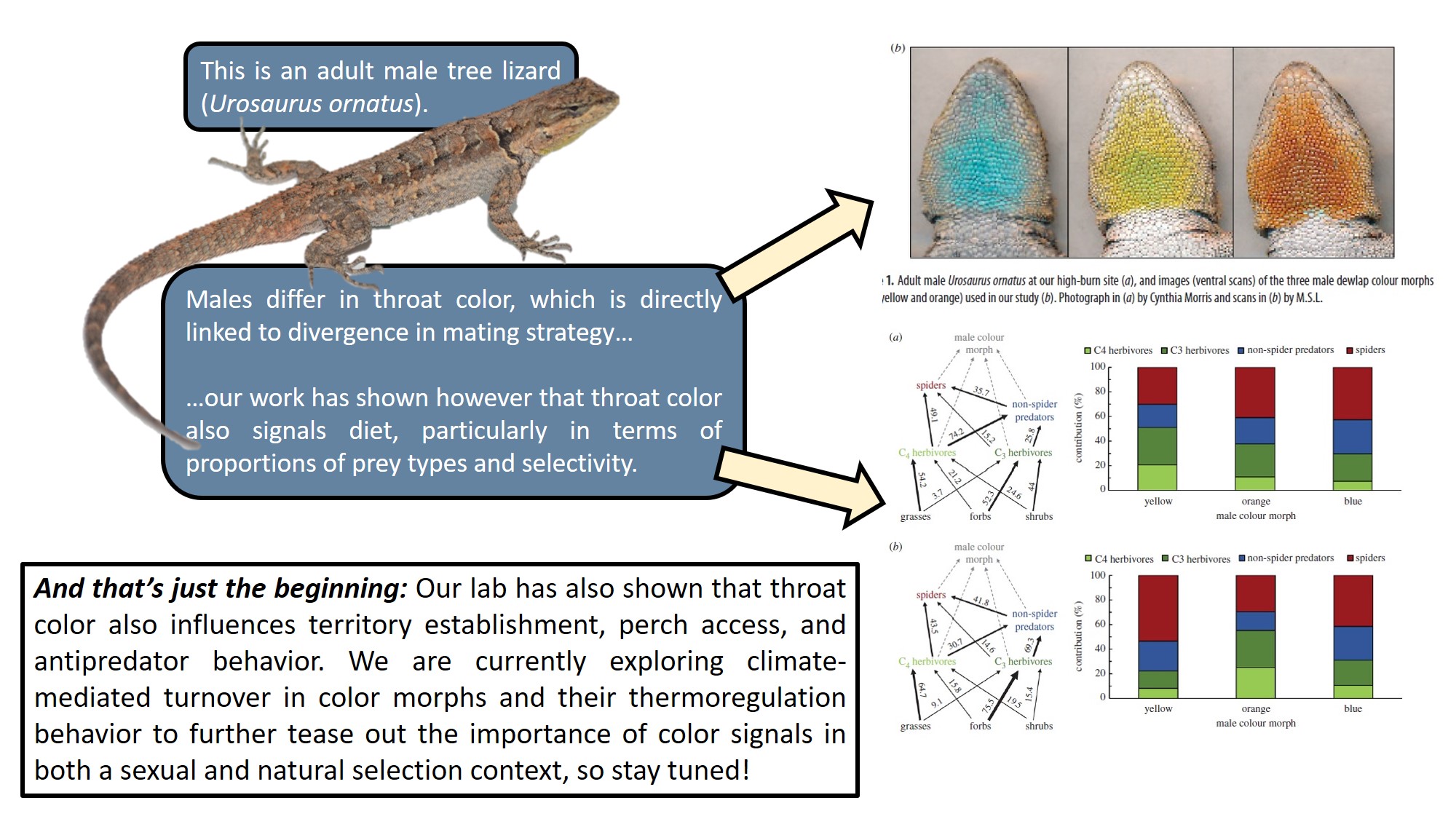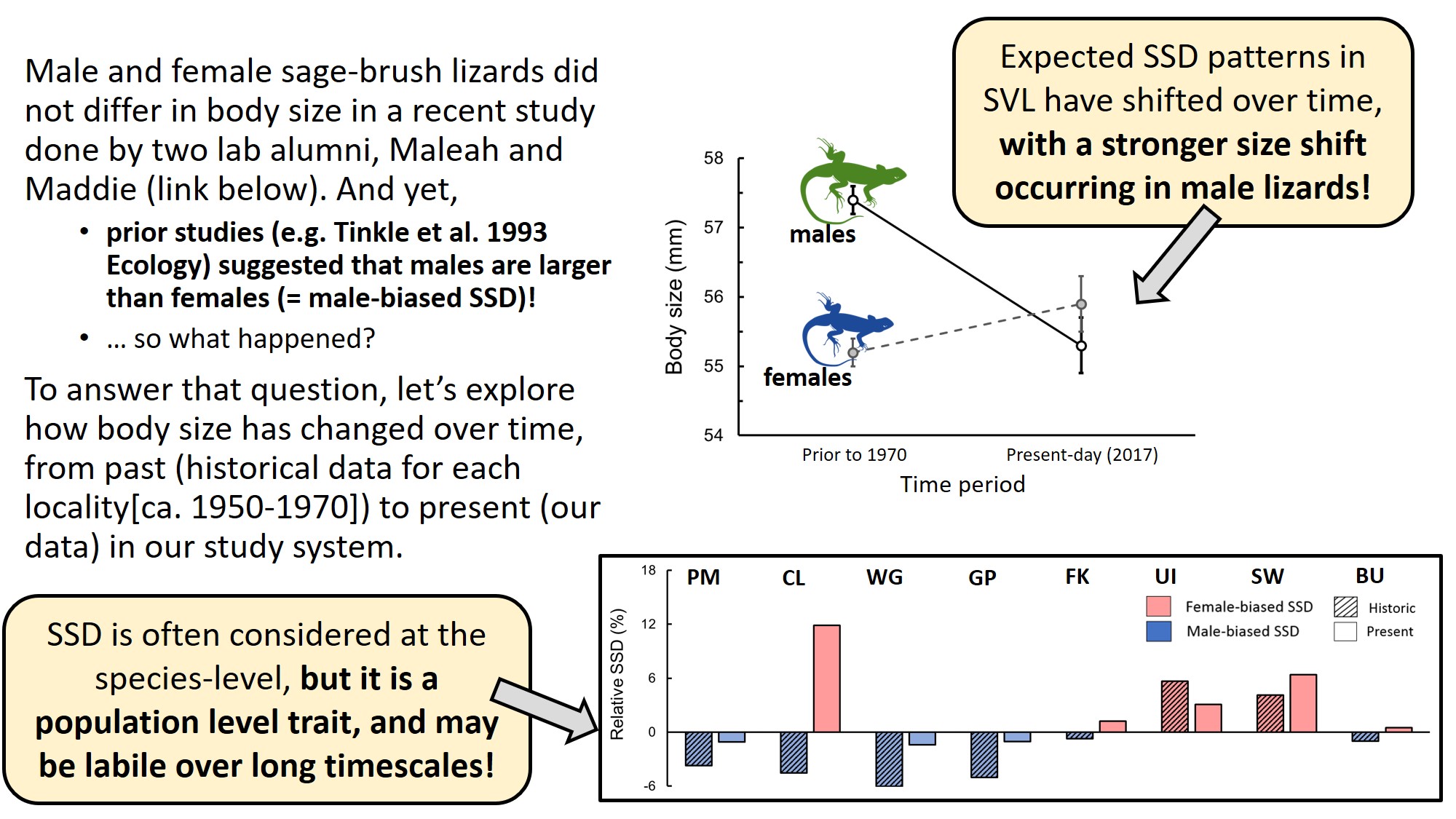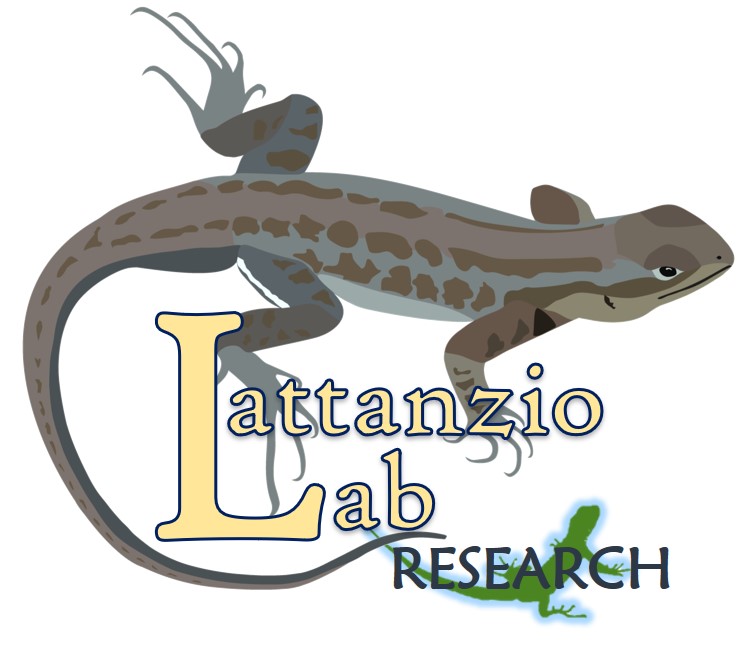"I am an evolutionary ecologist and my interests lie in how animals interact with and adapt to environmental variability, using reptiles and amphibians as a study system. Environmental variability represents one of the most pressing evolutionary challenges to species persistence and, more broadly, the maintenance of biodiversity. Such variability arises from numerous causes—from anthropogenic sources like prescribed fire and the growing threat of global climate change, to natural sources including elevation and latitude habitat gradients or the inherit diversity in social roles found within different mating systems. Regardless of its source (or sources), environmental variation has the potential to constrain the form, function, and behavior of individuals, the distribution and evolution of entire populations, and the structure and functioning of ecological communities. These considerations form the foundation for our lab's ongoing work."
-Dr. Lattanzio
Research in our lab integrates field, lab, community science, small electronics, and museum-based work; our approach draws inspiration from various biological sub-disciplines including ecomorphology, population ecology, evolutionary biology, physiology, thermal biology, and biogeochemistry. We have also begun developing our own sensors, loggers, and 'smart' experimental arenas, taking advantage of popular do it yourself (DIY) electronic platforms like Arduino and Raspberry Pi; check out some example projects and code via the 'Tools of the Trade' link in the side bar if you're interested.
Lab members pursue diverse experimental topics that don't necessarily align with Dr. Lattanzio's ongoing research in the western U.S., so if you're interested in our subject areas or research questions, contact us!
All of our current projects fall under one or
more of the following broad research foci:
Moving Beyond Thermoregulation: Reptiles require UV light, too!
Our lab has taken a deep dive into a bold new research area: Ultraviolet (UV) light regulation in reptiles! In other words, despite what you may have heard... temperature is NOT everything.
Let's step back a minute: as you may know, temperature is implicated in nearly every aspect of ectotherm ecology and evolution, from the timing and patterns of daily behavior to the capacity to engage in fitness-relevant physiological processes like locomotion and digestion, to name a few. As a result, these relationships serve as the primary (often sole) foundation of models of climate mediated extinction risk for these taxa (think major studies predicting extinction by 2100).
Underlying these considerations is the fact that reptiles, like other ectotherms, require exposure to external environmental conditions within a favorable range to maintain physiological homeostasis and satisfy fitness demands. However, over a century of studies have perpetuated the assumption that this process centers on body temperature regulation alone! While variation in temperature relationships is important for homeostasis (hey, even we study temperature relationships; check out our Publications page in the left menu!), the very nature of how researchers and the general public think about and study reptiles rests disproportionately heavy on their thermal biology. For example, two of the most fundamental reptile behaviors, basking and shuttling movements between sunlit and shaded habitats, are solely treated under the umbrella of so-called thermoregulation, and have thus historically been attributed to satisfying thermal physiology alone. Ultimately, this ongoing thermal bias has constrained our ability to appreciate the extent that other environmental conditions influence homeostasis in reptiles as well as their capacity to adapt to ongoing climate change.
Enter UV: Because basking and shuttling influence sun exposure, they also modulate exposure to ultraviolet (UV) wavelengths of light necessary for kickstarting the conversion of cholesterols in their skin to vitamin D3 (Fun fact: we can do this too!). Production of vitamin D3 depends on the extent of UV exposure, and studies have shown that solar UV exposure far surpasses dietary vitamin D3 acquisition in terms of increasing the concentration of vitamin D3 in circulation. The downstream impacts of this process are widespread and important in reptiles: studies have shown positive impacts of UV exposure on bone development, organ function, individual growth rate, long-term survival, and reproductive output, to name a few. Lab studies also suggest that lack of UV exposure, or exposure to extreme levels of UV, are fatal to reptiles. Importantly, a growing number of studies also support that reptiles can recognize and respond to UV light through both visual and parietal eye systems, which should jointly be adaptive for both recognizing and regulating solar UV exposure. Three conclusions may be drawn from these observations: UV exposure is necessary for diurnal reptiles, they have the capacity to perceive variation in UV exposure in their environment, and they should actively regulate their UV exposure to maximize fitness. Thus, behavioral interactions with solar radiation should involve regulation of both temperature and UV exposure. This consideration has multiple ramifications for our understanding of reptile ecology and evolution!
The big challenge with UV regulation studies is that prior work was necessarily indirect (e.g., use of fluid-filled models) because, well, there were no available data loggers or any way to record UV exposures in the lab or field over time. Perhaps we could press a button on handheld sensor every 30 seconds thorughout the day, following a lizard around as we do so, but that would be inefficient, stressful to the animal, and honestly a bit crazy. Back in late 2019 through 2020, I began diving into hobby electronics as a means to overcome this limitation. It turns out, folks had already created a demand for small-form UV sensors to determine wehther or not sunblock was needed for a day at the beach! Small electronics (working here with Arduino-based systems, but we've also worked with Raspberry Pi's too) have a learning curve, but a wonderfully helpful community too. After months of trial and error, and following the paths of others doing similar work (e.g., other researchers making temperature data loggers), I ended up making the world's first UV data logger for estimating lab-based UV preferences! The system relies on a UV sensor that we attach to the animal's dorsum, connects to a microcontroller via super-thin (< 0.2 mm diameter) wires, and can be programmed to record UV exposures at user-defined intervals (much like OMEGA data loggers record temperature during temperature preference trials). The system worked wonderfully and allowed us to provide the first insight into not only UV preferences in a lizard (eastern fence, that is!), but also evidence that UV preferences may take priority over temperature needs/risks (Conley and Lattanzio 2022; see below)!

Since that first project, I designed and tested field-based data loggers to record available (=operative) UV values at, again, user-defined intervals. The field loggers are mainly PVC-pipe housed with 3D printed caps and an upcycled USB cable to allow flexibility in placement. The best part about this system is that it can record values for at least TWO(!!) years! Found that out by accidentally leaving one on in storage for that duration, but it is great news for longer-term study efforts! The system is very straightforward and I've already been chatting with colleagues in academia and the zoo world for future collaborations. I also have a grant in review by NSF that we hope will be funded... it would allow expanding our efforts to a total of 11 lizard species in the US! Fingers crossed!
In the figure below, a) provides photographs of the field based logger itself as well as deployed in Arizona (2021 study), b) shows an example calibration of the UV sensor to a standard UV meter in field and zoo research (Solarmeter 6.5r), and c) shows a snapshot of Conley and Lattanzio (2022) whereby lizards exposed themselves to higher (near lethal) temperatures when UV light was available! Could UV matter more than temperature in some cases? We shall see!

Physiological and Ecological Consequences of Sexually-Selected Phenomena
Most work in this focus area occurs in the western US; however, we are beginning to conduct some research on the ecology of sexual-size dimorphism in eastern fence lizards here in VA. Broadly, we are interested in how traits and trait complexes classically attributed to sexual selection influence the ecology of individuals, populations, and entire species. Below I highlight some of that ongoing work with tree lizards and their male color polymorphism:

Understanding these unexpected outcomes often requires broader spatial (and temporal!) studies... basically, one population is not enough! This is one of our broader foci and as such involves several focal species (mostly lizards) and utilizes numerous techniques including physiological performance experiments, behavioral assays, field surveys, stable isotope analysis/diet reconstruction, social network analysis, and capture-mark-recapture methods, to name a few.
Ecological and Evolutionary Interactions with Environmental Variability
Environmental variability can take the form of a natural spatial gradient (e.g. field-to-forest transition) or be human-caused (e.g. land management, climate change, etc.). Climate change represents a major threat to biodiversity given its role in numerous cases of population extinction and community disassembly world-wide, highlighting a growing need to understand how species are responding to this ongoing threat. Our lab's recent efforts have centered on the influence of two key factors on these variable responses: diet selection and physiology. We are testing hypotheses related to this goal using lizards in the family Phrynosomatidae and salamanders in the family Plethodontidae, and our work combines biophysical modeling, climate projections, historical (museum-based) and contemporary (field-based) surveys, capture-mark-recapture methods, and physiological experiments. Thus far we've had some exciting results that are on the way to publication:

-
Read Maleah and Maddie's 2020 paper here.
Widespread species are often treated as ecological generalists, in part due to their capacity to exploit variably structured, social, and climatic habitats throughout their range. However, this assumption hinders our understanding of the diversity of adaptive processes occurring as these organisms experience novel and/or challenging environments. There are numerous examples of widespread taxa, and many of them happen to be reptiles. Lizards and snakes often exhibit especially wide ranges, even if the individual animals themselves are poor dispersers (i.e., many lizards). We take an ecological and microevolutionary approach towards addressing this goal that integrates intensive field work, citizen science databases, environmental niche modelling, physiological performance experiments in the lab, stable isotope analysis, and capture-mark-recapture methods to evaluate the potentially adaptive traits that make widespread species successful. We've even completed an entire project thus far focusing on only community-science (iNaturalist) data! Check out that student-driven paper here.
There is much more to our work than shown here; check out our publications page for more recent studies and reach out if you're interested in joining the team!

